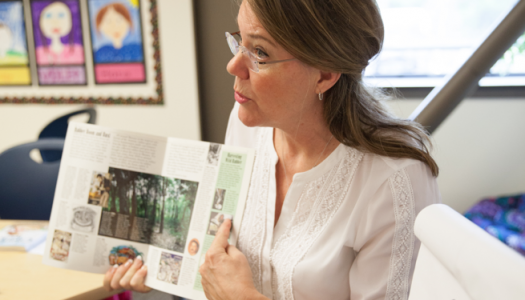An Insider’s View of a Brief Focus Lesson
Join Our Community
Access this resource now. Get up to three resources every month for free.
Choose from thousands of articles, lessons, guides, videos, and printables.
 Have you been looking for ways to enhance your brief focus lessons? Since you provide them to students every day, you want them to be direct, engaging, and fun!
Have you been looking for ways to enhance your brief focus lessons? Since you provide them to students every day, you want them to be direct, engaging, and fun!
Duration is key to the success of your lesson. That word brief in brief focus lesson is significant. Research has shown that students can attend only for as many minutes as their chronological ages. For example, if you are a second-grade teacher, your brief focus lesson should be about eight minutes long. The reason for this, of course, is obvious. After that recommended time, students will tune out—will they ever! To see just how they will tune out, take a look at The Sisters’ realistic (and humorous) observations of their students in The Daily 5 (page 29). Unfortunately, when students reach that point of no return, they will not retain the rich instruction that you share.
There are many ways to plan and deliver lessons, and here are some points to keep in mind as you prepare yours.
- Share Goal and Strategy. First, determine which goal would be most beneficial to feature in your brief focus lesson. Then decide which strategy to focus on, based on the needs of the majority of your class. Studying the Ready Reference Guides will give you a valuable overview of the strategy. Looking over the guides for Assessing Each Strategy will show you what mastery of the strategy looks like. When you begin the lesson, announce the goal and strategy to the group. Students who are already comfortable with that strategy will still benefit from the review. Based on your observations of students, you can plan small-group settings or individual conferring sessions to provide more practice for readers who need it.
- Observe and Relate. To engage readers, begin the brief focus lesson with a short anecdote or example that captures their attention. Ask students to recall other times when the class has used the target strategy or take the temperature of the room by asking children what they already know about the strategy. The intent is to present an introduction that sets the stage for the strategy work they will practice.
- Teach and Reinforce. During this part of the brief focus lesson, state the purpose clearly and reinforce the urgency of the strategy work. In all cases, strategy work is urgent because it helps children become readers, and it is fun. Once you have shared the purpose and generated a sense of urgency, move to explicit teacher modeling. Be animated so that students catch your enthusiasm! This is your time to show students how an expert reader (you!) uses the featured strategy.
Consider using a mentor text excerpt, projected with a document camera, to enrich your instruction. Or write the chosen excerpt on chart paper for easy reference. Just remember that you want everything to be ready in advance for the brief focus lesson so that you can keep it brief. Use sticky notes to mark important pages, key quotations, and noteworthy words and phrases for easy reference. Be prepared to think aloud so that students can witness how you process text and learn to follow your example of skilled reading. If thinking aloud doesn’t come naturally at first, rehearse your main points, or jot down what you plan to say.
- Practice. This aspect of the lesson is critical. You’ve modeled how to use the strategy, so now it’s their turn. Think about ways that you can give them this essential practice. Will you ask them to turn and talk with a partner about the strategy? Have you decided to list some sentence prompts that will structure the conversation? Will you ask children to show how they might apply the strategy to another example from your featured text? Do you plan to ask them to use the strategy with a good-fit book that they have brought to the carpet? Might you invite them to share their thinking or an example aloud or in writing on a sticky note? No matter what course of action you select, it should engage students with the strategy in a clear, streamlined manner.
- Encourage and plan. Success! You have delivered a clear and concise brief focus lesson that will strengthen students’ use of the highlighted strategy. You have demonstrated how to use the highlighted strategy and given them a chance to practice. Now that you have explored that strategy together, be sure to encourage students to use it—again and again. Invite them to think about ways that they can use the strategy during Read to Self or Read to Someone. Remind them that they can apply the strategy to other content-area reading.
After you create or enhance some of your own brief focus lessons, you will develop your unique insider’s view of how to do it. A template is available for your use at brief focus lesson Template (Behne, 2013). When possible, plan some brief focus lessons with your colleagues, or exchange those that you have prepared individually. Be on the lookout for excerpts from mentor texts that might be used to illustrate the CAFE Menu strategies. Remember that there are also brief focus lessons available for many strategies on The Sisters’ website. You can use them to generate your own ideas or customize them for your students.
References
Behne, A. (2013). Brief focus lesson template. Source.
Boushey, G., & Moser, J. (n.d.). Assessing student learning/Assessing each strategy. Source.
Boushey, G., & Moser, J. (n.d.). Brief focus lessons. Source.
Boushey, G., & Moser, J. (n.d.). Ready reference guides. Source.
Boushey, G., & Moser, J. (2009). The CAFE book. Portland, ME: Stenhouse.
Boushey, G., & Moser, J. (2014). The daily 5 (2nd ed.). Portland, ME: Stenhouse.






